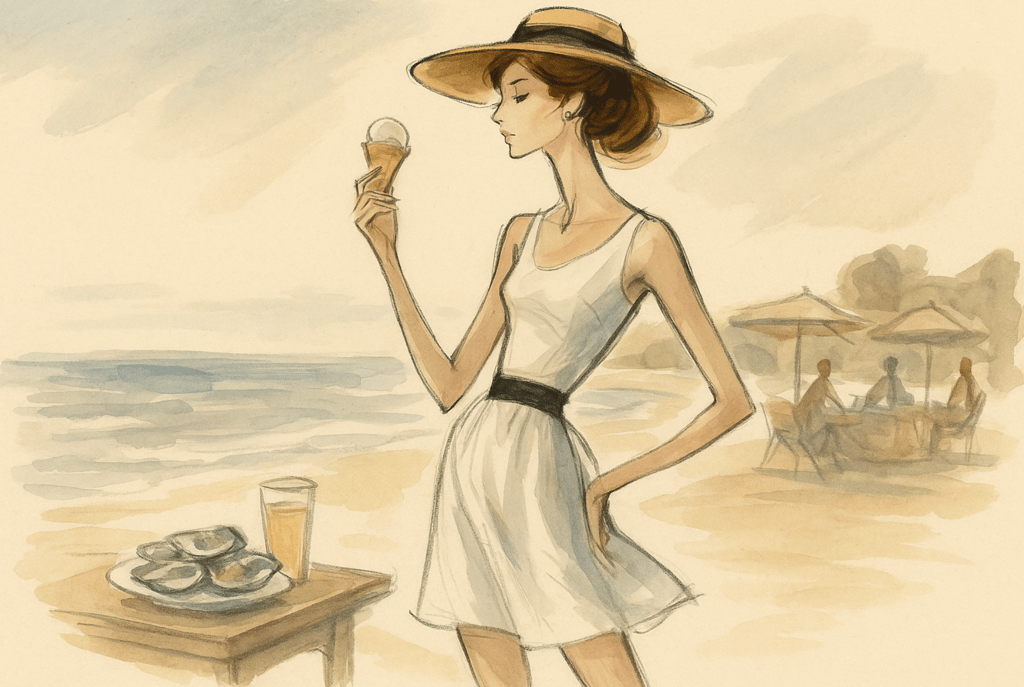The Invention of the Beach Snack: From Oysters to Ice Cream
Before boardwalk fries and ice cream, beach snacks were oysters, lemonade, eggs, and fruit. Discover the history of seaside eating from 18th-century Europe to today.
FOOD HISTORY & TRADITIONS


When we picture eating at the beach today, certain images spring to mind: ice cream dripping down a cone, a bag of chips, maybe a hot dog grabbed from a boardwalk stand. But the earliest beach snacks—the foods enjoyed by those first waves of seaside holidaymakers—looked nothing like our modern idea of “holiday food.”
In the 18th and 19th centuries, as trips to the seaside became fashionable across Europe, beachgoers fuelled themselves not with fried food or sweets, but with oysters, lemonade, hard-boiled eggs, and simple fruit. These snacks reflected both the tastes and the practical realities of the time, long before seaside kiosks, cafés, or boardwalks existed.
Seaside Holidays and the Rise of the Snack
Seaside tourism began as a trend among Europe’s elite in the 18th century, spurred by doctors who touted sea air and cold-water bathing as cures for everything from melancholy to skin ailments. By the early 19th century, railways and growing middle-class leisure time made beach trips more accessible.
But with more people flocking to the shore came a simple problem: what would they eat? Most resorts lacked restaurants or facilities along the sand, and bathers weren’t inclined to walk back to lodgings every time they felt hungry. Enter the itinerant vendors, who carried trays, baskets, or carts along the beaches, selling foods that were cheap, portable, and could survive in the summer heat.
These offerings would become the first true “beach snacks.” They weren’t about indulgence so much as convenience and sustenance, though a few became small luxuries in their own right.
Oysters: The Original Beach Treat
It might surprise us today, but in the 18th and early 19th centuries, oysters were a cheap and common snack, not a luxury food. Abundant along European coasts, they were easy for vendors to collect and sell fresh to beachgoers, sometimes shucked on the spot.
Holidaymakers, still damp from sea baths, might stop to slurp a few oysters before returning to the waves. They were nutritious, briny, and considered fortifying—a far cry from the dainty, expensive delicacy they became in the 20th century. For working-class visitors, oysters were especially appealing: they were filling and often cost less than bread or meat.
Some resorts even went a step further, establishing makeshift oyster bars right on the sand. These were little more than tables shaded by cloth awnings, where bathers could gather for a dozen oysters and perhaps a mug of ale or cider, turning the snack into a social moment as much as a meal.
Lemonade, Fruit, and Other Early Refreshments
While oysters offered protein, another staple of early beach eating was lemonade. Vendors touted it as both cooling and healthful, selling it by the glass or in chilled bottles. Doctors often recommended citrus drinks as “restorative tonics” after the shock of cold sea baths, believing the sugar and acidity helped balance the body.
Alongside lemonade came other practical, portable foods: hard-boiled eggs, apples, plums, and simple biscuits. These items were easy to carry, resistant to spoilage, and could be eaten quickly between swims. Some vendors sold roasted nuts, another shelf-stable snack for beachgoers with a few extra coins.
For wealthier visitors, seaside snacking looked different. Servants often packed full cold spreads—cold meats, bread, cheese, and wine—transforming beach visits into miniature picnics. These private feasts reinforced class distinctions, but they also planted the seed for the seaside picnic as a broader tradition, which would flourish in the Victorian era.
From Vendors to Resorts: The Birth of the Modern Beach Snack
By the late 19th and early 20th centuries, the seaside was booming. Resorts expanded, boardwalks were built, and entrepreneurs saw an opportunity to turn beach eating into big business.
Permanent kiosks and cafés began offering fried foods, sweets, and ice cream, reshaping what people expected to eat by the sea. These new treats—cheap, fun, and indulgent—reflected the era’s shift toward leisure and pleasure. Eating at the beach was no longer just about staying fed; it became part of the entertainment.
Ice cream, in particular, became synonymous with seaside trips by the early 20th century, as portable cones and mechanised freezers made the frozen dessert more accessible. Oysters, once the beach snack of choice, became scarcer and more expensive, retreating from the shoreline to high-end restaurants.
Fun Fact: Oysters Were Once Beach Fast Food
In the early 1800s, oyster vendors didn’t just serve beachgoers. In some English seaside towns, they even made deliveries to bathers, wading into the shallows with trays so customers could enjoy a salty snack without leaving the water. Imagine eating oysters waist-deep in the sea—an experience as far from today’s boardwalk fries as you can get.
Why These Early Snacks Still Fascinate
The story of the first beach snacks offers a window into how seaside leisure evolved. What began as a practical solution to hunger on the sand became a tradition tied to culture, class, and indulgence.
It also reminds us that foods we now see as luxuries—like oysters—were once everyday fare, while the sweets and fried foods we associate with the beach today only arrived with industrialisation and mass tourism.
The next time you unwrap a cone of chips or lick melting ice cream by the sea, remember those first holidaymakers: sipping lemonade, biting into plums, and slurping oysters under the same summer sun, centuries before our familiar boardwalks existed.
